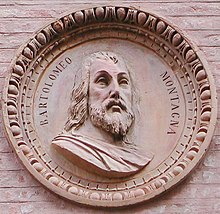Bartolomeo Montagna

Bartolomeo Montagna (1450–1523) was an Italian painter and architect who worked in Vicenza and Venice. He putatively was born near Brescia. His initial training was presumably under Domenico Morone in Verona, where he seems to have acquired a late Quattrocento refinement, similar to that of Carpaccio and Mantegna. The figures have a strict organization in space, and the peaceful expressions of classic detachment. He is also considered to be heavily influenced by Giovanni Bellini, in whose workshop he might have worked around 1490. Benedetto Montagna, a productive engraver, was his son and pupil and active till past 1540. Marcello Fogolino was one of his pupils.

He was commissioned by the Bishop Pietro Barozzi with some of the wall decorations of the throne room of the Bishop's Palace (Palazzo Vescovile) of Padua, depicting portraits of early bishops of the Veneto.[1]
Sources
- Catholic Encyclopedia article
- Freedberg, Sydney J. (1993). Pelican History of Art (ed.). Painting in Italy, 1500-1600. Penguin Books Ltd. pp. 355–356.
- Oxford Art Online article
- Artcyclopedia
